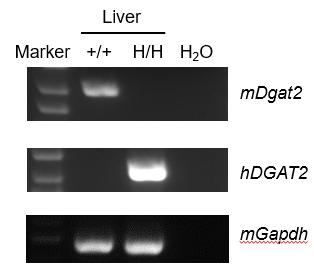
C57BL/6-Dgat2tm1(DGAT2)Bcgen/Bcgen • 113047
Gene targeting strategy for B-hDGAT2 mice. The exons 1-8 of mouse Dgat2 gene that encode the whole molecule (ATG to STOP codon), including promoter, 5’UTR and 3’UTR were replaced by human counterparts in B-hDGAT2 mice. The human DGAT2 expression is driven by endogenous human DGAT2 promoter, while mouse Dgat2 gene transcription and translation will be disrupted.

Strain specific analysis of DGAT2 mRNA expression in wild-type C57BL/6JNifdc mice and B-hDGAT2 mice by RT-PCR. Liver RNA were isolated from wild-type C57BL/6JNifdc mice (+/+) and homozygous B-hDGAT2 mice (H/H), then cDNA libraries were synthesized by reverse transcription, followed by PCR with mouse or human DGAT2 primers. Mouse Dgat2 mRNA was detectable in liver of wild-type C57BL/6JNifdc mice. Human DGAT2 mRNA was detectable only in liver of homozygous B-hDGAT2 mice but not in wild-type mice.

Strain specific DGAT2 expression analysis in wild-type C57BL/6JNifdc mice and humanized B-hDGAT2 mice by Western blot. Various tissue lysates were collected from wild-type C57BL/6JNifdc mice (+/+) and homozygous B-hDGAT2 mice (H/H), and then analyzed by western blot with anti-DGAT2 antibody (Proteintech, 17100-1-AP). DGAT2 was detectable in liver and adipose of wild-type C57BL/6 mice and homozygous B-hDGAT2 mice due to the cross-reactivity of antibody.

The inhibitory efficiency of the nucleic acid drugs against human DGAT2 mRNA in liver tissue in homozygous B-hDGAT2 mice. B-hDGAT2 mice were randomly divided into two groups (9 weeks old). The human DGAT2-targeted nucleic acid drugs (synthesized according to patents) and PBS were administered individually to the mice. The nucleic acid drugs were administered in the form of PBS aqueous solution. The mice were sacrificed on day 7, and the liver tissue was collected to detect the expression level of human DGAT2 mRNA by qPCR and liver triglyceride (TG). (A) The schematic diagram of experimental processing. (B) The expression of human DGAT2 mRNA in liver after treatment. (C) The liver triglyceride (TG) expression after treatment. The human DGAT2 in the treatment group and the liver TG were reduced compared to the control group, demonstrating that B-hDGAT2 mice provide a powerful preclinical model for in vivo evaluation of human DGAT2-targeted nucleic acid drugs. Values are expressed as mean ± SEM.